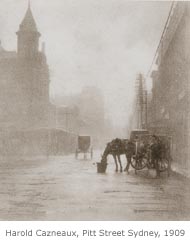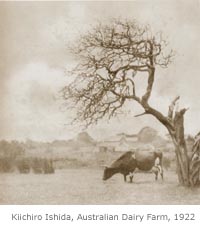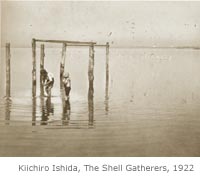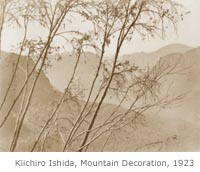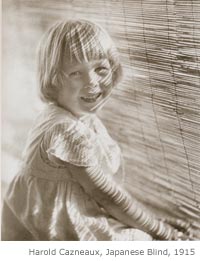and the Sydney Camera Circle
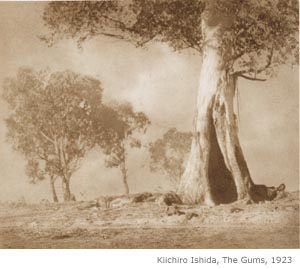
Modernism/Japonism in Photography 1920's-40's
In 1919, Kiichiro Ishida was posted to Sydney, Australia, to work for
the Okura-Gumi trading company. It was here that a Japanese photographer
friend also living in Sydney introduced him to the art of photography.
Within a year, Ishida's photographic work was of such a standard that
it was accepted for exhibition at the prestigious London Salon of photography
organized by the Royal Photographic Society.
Within two years, he was invited to join the influential Sydney Camera
Circle. The aim of this small group was to further photography as an art
form and to exhibit their work internationally. An exhibition at the Shoto
Museum displays the work of Ishida as well as many of the works of fellow
Sydney Camera Circle members. Among these are the noted works of Harold
Cazneaux, a seminal figure in the history of Australian photography.
Photography had its roots in a Victorian romantic pictorialism. Exaggerated
dramatic poses and gloomy, dark landscapes characterized the dominant
style at the turn of the 19th century. The British Royal Photographic
Society, asserted a strong stylistic influence. The Sydney Camera Circle
members were intent on creating a distinctly Australian style. This was
characterized by an emphasis on sunlight, atmosphere, nature and people
in everyday scenes of work and leisure. Ishida was quickly influenced
by their style and in particular by the work of Harold Cazneaux.
Ishida's photography is noted for his use of the Bromoil print process.
This process, developed early in the 19th century consisted of a positive
image on treated paper. It was based on the principle that oil and water
do not mix. Once an enlargement was made, it was bleached to remove the
black silver image. Greasy inks of various colors were then applied to
the damp paper using special soft brushes. The raised gelatin areas, damp
with moisture, repelled the oil-based inks.
Various tones and textures could be attained by careful brushwork. The
process resulted in soft atmospheric and delicate works of which Ishida
was a master. He was responsible for the reinvigoration of this process
in the Sydney Camera Circle as well as in Japan. Many of the Sydney Camera
Circle member's works are on display in this comprehensive exhibition.
Ishida's works differed from his colleagues in the Circle. A spare composition
and lack of strong perspective characterize his images. His works such
as The Shell Gathers (1922), The Gums (1923), and Mountain Decoration
(1923) display a distincly Japanese aeshetetic; a flatness and a composition
more akin to Sumi-e (scroll painting) or Ukiyo-e (woodblock prints).
After five years in Sydney Ishida returned to Japan and continued exhibiting
his work, as well as, exhibiting the work of the Sydney Camera Circle
that he had brought with him. Later, Ishida also spent time in Tianjin
and Beijing where he photographed the villages, peasants, and the rural
landscape of China. On his return to Japan after the second World War
Ishida stopped his photography and devoted himself to running the family
business and local politics.
Many Japanese artists traveled to Europe to further their artistic careers
and education. Many were part of art movements such as surrealism, but
few are noted in the history texts or recognized outside of Japan for
their achievements. This exhibition is unique in that it traces the origins
of a Japanese artist who initially achieved acclaim overseas and then
became an important stylistic influence in Japan.
Kiichiro Ishida's work has been recognized in Australia and Japan. Both
countries sat on the edge of the dominant western European artistic tradition.
This exhibition is a unique opportunity to trace the career of an influential
Japanese photographer and to see the works of an important artistic group
who explored a new vision for photography.
